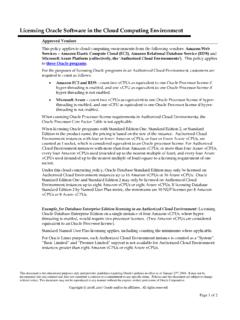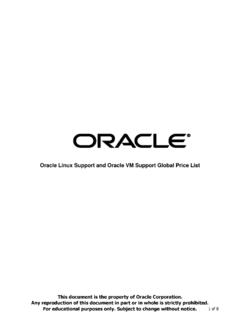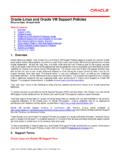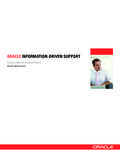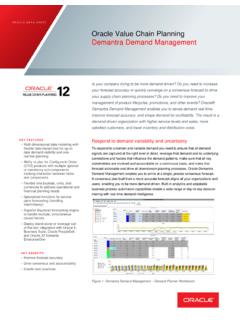Transcription of Oracle Utilities Customer Care and Billing 2.5 Benchmark ...
1 Oracle Utilities Customer care and Billing Benchmark Report Demonstrates Superior Performance and Scalability O R A C L E W H I T E P A P E R | A P R I L 2016 1 | Oracle Utilities Customer care AND Billing Benchmark REPORT Introduction Oracle Utilities Customer care and Billing (CC&B) is a mature, flexible, highly-scalable Customer Information System. It is designed to meet the needs of electric, gas, and water Utilities ranging from those that have a few thousand customers to those that have many millions of customers.
2 Oracle Utilities CC&B handles every aspect of the Customer lifecycle from the service connection, meter reading, and field work to rating, Billing , payments processing, and collections. Oracle Utilities CC&B delivers comprehensive contact center capabilities with integrated Customer relationship management and program management features. It allows Utilities to improve Customer service, enhance financial performance, and adapt to a changing industry. For today s Utilities , business growth is a key concern. Whether that growth is due to organic Customer -base expansion, mergers and acquisitions, or expansion of services the utility offers, Utilities require a software and hardware solution that can provide them with scalability and flexibility to grow seamlessly and avoid many challenges that are often inherent to this type of expansion.
3 With respect to Customer information systems, utility business growth has a major impact on the business processes required to serve customers efficiently. It is critical that Utilities have confidence that their fundamental Billing services will continue to perform efficiently, with no disruptions in their critical meter-to-cash process flow, as the amount of Customer information and processing needs grow. Oracle Utilities CC&B marks a major change in application technology as it is an all Java-based architecture. This whitepaper describes the performance and scalability results of Oracle Utilities CC&B version Summary It was demonstrated that the performance of Oracle Utilities CC&B is at least 15 percent better than that of Oracle Utilities CC&B (COBOL-based architecture) in all use cases tested.
4 It scales linearly as more hardware is added for both batch and online transaction processing (OLTP). On-line performance remains statistically unchanged. 2 | Oracle Utilities Customer care AND Billing Benchmark REPORT Overview The following use cases were executed to test the performance and scalability of Oracle Utilities CC&B Batch Billing involving a mixture of residential, commercial and industrial accounts for non-interval electric service or non-interval gas service Online workload for a user Adding a case and Customer contact Bill and Service Agreement (SA)
5 Inquiry Freezing a bill, adding a payment, and updating person and account records Methodology Data Accounts The tests were performed using ten million accounts. The following outlines the breakdown of these ten million accounts: Residential accounts (5 million) 3 million with gas service. 2 million with electric service Commercial accounts (3 million) 2 million with gas service 1 million with electric service Industrial accounts (2 million) 1 million with gas service 1 million with electric service Number of Calculations in Rate Schedules Calculations are special algorithms or logic that calculate quantities to be billed and determine the required charges, discounts, etc.
6 Each calculation corresponds to a potential calculation line that can appear on a bill. The following outlines the number of calculations in each of the rate schedules used to bill for the gas and electric services. Residential gas service 3 calculations Residential electric service 14 calculations Commercial gas service 8 calculations Commercial electric service 19 calculations Industrial gas service 8 calculations Industrial electric service 133 calculations Historical Data The tests used three years of historical financial data for ten million accounts.
7 3 | Oracle Utilities Customer care AND Billing Benchmark REPORT Testing Scenarios Batch Billing The tests simulated a typical utility use case where the 10 million accounts are divided into twenty groups, so that one-twentieth (5 percent) of all customers are billed each night on each of the 20 working day during the month. This results in 500,000 bills being generated per day. Online Workload Testing The use case for online workload testing simulated the most common types of actions a user would perform. One iteration of the use case comprised a single user executing a total of 18 operations associated with the three scenarios outlined earlier in this document.
8 Adding a case and Customer contact (consisted of 4 operations) Bill and Service Agreement (SA) inquiry (consisted of 4 operations) Freezing a bill, adding a payment, and updating person and account records (consisted of 10 operations) The work rate per user included simulated user think time with the time to complete one full iteration being approximately seconds. Database Partitioning All tests were executed with the database objects partitioned ready for Information Lifecycle Management (ILM). 4 | Oracle Utilities Customer care AND Billing Benchmark REPORT Technical Architecture The tests were executed on Sun Server X4-2 servers running Oracle Linux , with 2 x 12 core Xeon processors, and a Sun ZFS Storage 7420 Appliance.
9 Figure 1. Oracle Utilities Customer care and Billing (CC&B) Performance Benchmark Technical Architecture Results Oracle Utilities CC&B (Java-based architecture) demonstrated that performance is at least 15 percent better than Oracle Utilities CC&B (COBOL based architecture) in all use cases tested. Batch Billing Oracle Utilities CC&B (Java-based architecture) with a deployment of 10 million accounts: Processed 500,000 bills within 45 minutes using 40 application server cores and 24 database server cores. Demonstrated up to 15 percent better computational efficiency relative to Oracle Utilities CC&B (COBOL-based architecture) on the same system.
10 The number of batch threads per threadpoolworker Java Virtual Machine (JVM) increased dramatically. It showed that the application server RAM footprint for Oracle Utilities CC&B is at least 25 percent lower than previous versions. 5 | Oracle Utilities Customer care AND Billing Benchmark REPORT SQL improvements against the Bill and Bill Segment tables reduced database Input / Output Operations per Second (IOPS) demand by at least 40 percent compared with Oracle Utilities CC&B This reduced demand is dependent on the amount of historical data in the system, with longer history potentially seeing greater savings.
